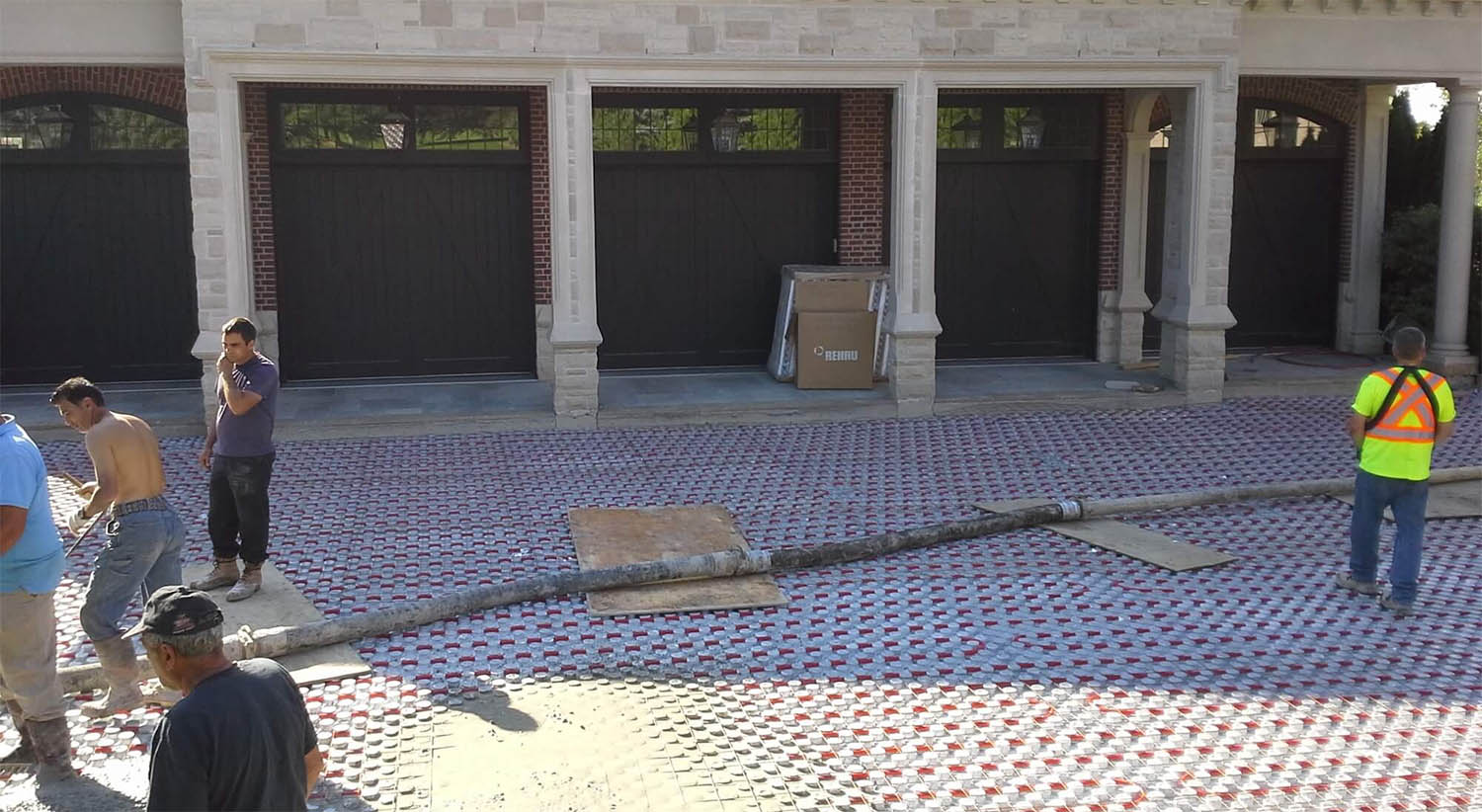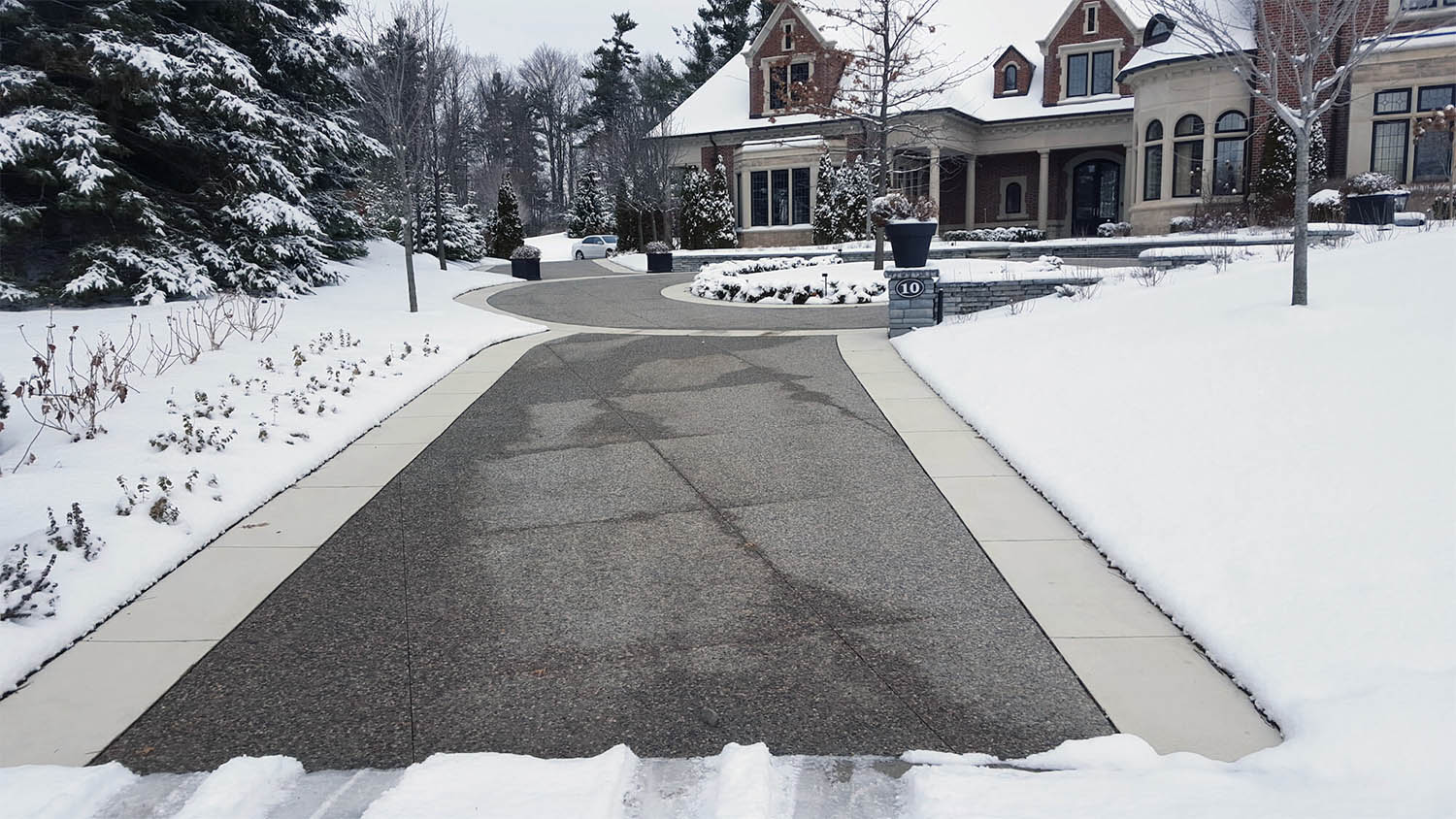Heated Driveways. Everything You Need To Know
We get asked by customers all the time about heated driveways. What do they do, how much do they cost, do they really work and are they worth it are a few of the most common. Ahead we’ll answer all those questions and a bunch more.
Heated driveways are warmed by a form of radiant floor heating meant for the outdoors. Tubes filled with hot water and an anti freeze solution or electric coils are installed under the driveway’s surface. When it gets cold enough, either hot water is pumped through the tubes or an electric current is sent into the coils which creates heat. That heat radiates upwards, warming the surface. Heated driveways have a single purpose and that’s snow and ice removal. If you live anywhere cold then you’ve probably spent countless hours each winter shoveling your driveway. Or paid someone else to do it for you. Well you won’t have to any more if you install a heated driveway.
Having to shovel your driveway every time it snows is back breaking work that can lead to injury. Snow blowers are expensive, they break down whenever you seam to need them most and spreading salt is a pain. Even if you don’t live in a region that gets hit with heavy snow, black ice in the early mornings can still be an issue. Snow-melting systems work by heating the driveway from underneath the surface, ensuring that snow and ice never stick to the pavement.
How Do Heated Driveway Systems Work?
Heated driveways are actually a form of radiant floor heating system. The same basic system you install to heat your bathroom floor can be used to heat your driveway. However for outdoor use the system is much stronger. The heating system sits just under the finished flooring layer. In this case the pavement, concrete, pavers, black top, etc. When temperatures drop cold enough for ice to form or when it snows, the system heats up. Heat radiates upwards warming the floor. This heated floor is enough to melt snow and ice.
A thermostat that controls the system can be installed anywhere inside the house or garage. The system can be set to come on automatically or you can do it manually. It’s just like using the thermostat inside your home.
There are also systems you can control remotely via an app so you can heat things up even when your not home.
Hot water heated driveway system. PEX tubing tied to wire mesh beneath a future concrete driveway.
Lots Of Heated Driveway Options
Driveway heating systems can be installed under almost any surface. This includes concrete, black top, pavers and brick. And these radiant systems aren’t just for driveways either. You can install them under your walkways, front stoop and sidewalk too. Pretty much any masonry surface can be heated with a radiant heating system.
Remember that with a hot water system, it’s best to have your boiler placed as near as you can to the driveway. In order for it to work properly all the water throughout the entire system has to be pumped with hot water so it’s best to have the hot water source as close by as possible. We generally install it in the garage.
With an electric system the distance from the power source to the driveway doesn’t matter.
There are lots of options in terms of controls too. Turn it all off and on with a switch or control it with a thermostat. That thermostat or switch can then be programmed to come on at predetermined times, operated by hand, with a sensor system that detects snow and ice or via an app on your smart phone.
Heated Driveway Costs
There’s no way we can give you an average total for what a heated driveway system costs but we can give you an average price per square foot and a general breakdown of all the work required.
Radiant Hot Water Driveway Cost
On average you can expect to pay around $12-$25 per square foot for a hot water radiant system. This includes all the PEX tubing under driveways surface and labor. Then you’ll have to install the water heater, pumps, thermostat / controls and sensors. Expect to pay another $4-$7k for an average sized 2 car driveway.
These prices don’t include demo of the old driveway if you need it or the installing the new driveway. Those expenses are a whole other blog post.
- Get estimates from some local pros. The numbers listed above are averages for what we charge in NJ at the time we wrote this post and may not apply to where you live. Always get an accurate bid from someone who would actually do the work.
- If your replacing your driveway or building a new home, then upgrading to a heated driveway system might be a smart idea if you’ve got snow and ice to deal with every winter.
DIY Tip: If you’re capable of demoing the driveway and disposing of it yourself it could save you a bundle. If you want to save then this is the part of the job where you can do it. The pros that do this type of work don’t want to do demo and usually just sub it out to a demo company plus some profit on top. Save all that money by renting a demo bobcat and a dumpster for a day or two.
Electric Heated Driveway Cost
These systems are a lot harder to give a range for because they vary so much. And there are a lot more options including a range of DIY kits. All you really do is roll the mats out under the driveway surface, connect them to one another and then to a power source. It’s all super easy. If you plan on doing the work yourself we’d recommend hiring an electrician to connect the system to a power source. We also recommend the system having it’s own fuse.
The system we professional install which has an array of coils runs about $10 per square foot plus the electricians fees and the cost of the controls, sensors and thermostat. Again, this does not include the cost to demo the old driveway or installing the new driveway.
Hot water heated driveway system. PEX tubing laid inside forms. Wire mesh and concrete come next.
Types Of Heated Driveway Systems
There are two main types of heated driveway. Hot water or electric.
Hot Water “Hydronic” Heated Driveway
Hydronic driveway heating systems are installed by placing a closed system of plastic tubing beneath the surface of the driveway. A boiler is used to heat a water and anti freeze mix that gets pumped through the tubing. The hot water heats the ground in order to melt snow and ice above before it accumulates.
These systems works exactly the same as radiators or baseboard heating inside the house. Instead of hot water heating a radiator it heats up tubes under the driveway. And those hot tubes heat the ground which melts snow and ice. It’s all very simple. The system has it’s own hot water heater and thermostat.
Pros Of A Hydronic Driveway System
The main advantage of a hydronic system is the cost to operate it. No matter what fuel source you use to heat your water, propane, oil, or natural gas, it’s cheaper than an electric system to operate.
A hot radiant heating system for your driveway really does work. You won’t have to worry about shoveling or spreading salt ever again.
Hydronic systems are reliable and last a long time. Generally they come with a 30 year warranty.
The radiant heat system under the driveway requires no maintenance. However you do have to make sure the boiler and pumps are working correctly just like you do with heating system inside the house.
With a hot water radiant driveway system you have some options. Either a standard tank water heater or tankless system will work. We recommend going a size bigger on a tank or tankless water heater which appropriate for the size of your driveway just in case. It’s always better to have a little more capacity if you need it.
Cons Of A Hydronic Driveway System
Hot water radiant heating systems can’t be installed properly under a driveway that already exists. Homeowners can only install one if they’re willing to replace the entire driveway. This can be a big issue if you like your driveway however if your building a new home or replacing the driveway anyway then it’s not a problem.
PEX tubing is easily damaged by animals. Rodents can chew through it very easily. Because of this, PEX tubing is banned from all use in NYC. They only allow copper tubing because of all the rats. If you have a hydronic system then make sure rodents don’t dog anywhere around the pipes because they’ll gnaw at them and cause a leak.
Hot water radiant heating systems are expensive to install. Even though long term they’re cheaper to operate than electric, the up front installation costs are high. This is because you not only have to install all the tubing but also the hot water heater, pump and controls.
Hot water radiant heating systems take longer to get hot than an electric system. This isn’t really a problem but when you compare electric heat to water, electric heats up faster. This is because the hot water has to circulate throughout all the tubes replacing all the cold water. It can take a while depending on how big your driveway is.
Electric heated driveway mat being rolled out.
Heated Driveway DIY = Electric Mats
Electric driveway heating systems are made up of heating cables laid out on the driveway’s bedding layer. These radiant heat mats warm up the surface layer which melts snow or ice. The cables can be linked to one another to form a large circuit or wired individually to an electric power source, which, in most cases, is the house’s central power box. We recommend running the system on it’s own fuse.
Just like with hot water radiant heat the entire system is controlled by a thermostat. And that thermostat can be programmed, turned on and off with a switch, or remotely controlled by an app.
Electric heated mats come in a variety of styles and sizes. Heated driveway DIY kits are sold online that are super easy to install. They generally have less power and a shorter warranty. Professional systems come with a longer warranty and a lot more power.
The photo above is off a professional grade system with much thicker cables than a DIY system has. Thicker cables means more power which in turn means more heat.
Pros Of An Electric Heated Driveway
Electrically heated driveway systems have a few advantages over hot water.
Electric driveway heating systems are easier and less expensive to install. In fact they’re so simple there are even DIY options which we’ll link to below.
Unlike a hot water system, electric mats can be worked into preexisting concrete driveways.
Electric systems can heat a driveway faster than hot water can because they don’t take as long to heat up.
Cons Of An Electric Heated Driveway
Even though electric is cheaper and easier to install up front, they’re more expensive to run that hot water.
If a house doesn’t have enough electrical capacity to the system properly then you may have to use a capacity expansion or secondary source.
An electrical heating system should run on it’s own fuse which means you’ll need enough space inside your electrical panel for one. If your panels full then you may have to install a sub panel.
If the power goes out, which happens here in NJ all the time when it snows, the heated driveway won’t work. And even if you have a generator it draws power away from more important things like your lights and refrigerator.
Heated Driveway Mats
There are two types of heated driveway mats you can buy. Below we’ll discuss both.
Below Ground Heated Driveway Mats
When you’re installing a driveway made of pavers, asphalt, or concrete and you want it heated, heated driveway mats are a great option. Heated driveway mats are basically electrical coils running throughout a mat. You simply roll them out under the finished driveways surface. You can either connect them all together to form one big circuit or wire them independently. Heated mats make a great DIY project however we do recommend hiring an electrician when you connect them to power. We also recommend running them on their own dedicated circuit and fuse.
You’ll enjoy not having to shovel your driveway or spread salt this winter once you’ve got a heated driveway. Since the driveway surface absorbs heat from the radiant mats underneath, the snow and ice melts and all you have to do is flick a switch. Mat control systems are available with sensors that detect things like air temperature or moisture on the pavement.
Most DIY mat systems come with a ten year warranty and deliver approximately 50 watts of heat per square foot. Although the mats a professional generally installs come with a much longer warranty, some up to 30 years, and a lot more power.
A variety of controller options are also available. You can set them to work on a timer, when you flick a switch, remote controlled via an app or based on sensor readings.
Above Ground Snow Melting Mats You Can Drive On
Above ground heated driveway mats you can drive on are a great way to melt snow and ice on an existing driveway. They’re durable enough to withstand the weight of your car and last for years outside in the elements. You lay them out right on top of your driveway. The mats are designed to lay underneath the cars tires forming a track. You drive right on top of them, one mat goes under the right side tires and one under the left. When it snows out or gets icy, you turn the mats on and they heat up. It’s as simple as that. They get so hot snow and ice can’t stick to them so you can freely drive in and out of your driveway.
Above ground heated mats provide the heated driveway you’ve always wanted at a fraction of the cost.
Made of thermoplastic material, heated driveway mats are portable and designed to be left outside all winter long. And best of all they connect to any outdoor outlet so there’s no complicated wiring involved.
These heated floor mats generate enough heat to melt snow at a rate of around 2″ per hour. So in heavy snow conditions or extreme cold they won’t work as well. But they’re great for light snow and melting black ice.
These mats can also be laid out to form a walkway from your car into the house so you don’t have to worry about spreading salt or shoveling again unless you get some very heavy snow.
Controlling A Heated Driveway
Another thing to consider is how you’d like to control the system. Manually or automated.
An automated system has sensors that detect snow and ice build up. Once the sensors are triggered your heating system turns on and heat the driveway. The benefit of a setup like this is total automation. You don’t have to do a thing other than turn the sensors on once winter hits. The downside is that you give up control to a computer which means it may turn on when you don’t want it to. Another negative is the system drawing power all the time, in order for sensors to work properly you can’t turn them off. It doesn’t cost much over a season but it’s more than you’ll spend with manual controls.
However a manual system allows you to save a little money since you only turn the heat on when you actually need it. The system turns on at the flick of a switch.
Another great option are apps you can control remotely. Turn the system off and on whenever you like from wherever you are. It’s a great feature to have if you don’t like the automated system but aren’t always home to switch the system on. This is the option we recommend most to our customers.
With any of the control options you can adjust the temperature inside the tubes or coils via the thermostat and all of these setups are available for either an electric or hydronic system.
Heated driveway in Winter.
Which Pavers Work Best with Radiant Heating Systems?
Just about any type of concrete paver can be a good choice for a heated driveway’s surface.
After all the pavers are installed, the driveway surface won’t show any sign of heated mats or radiant tubing underneath.
Permeable (porous) pavers are the best choice for heated driveway projects. As the radiant heating system melts ice and snow, the water left behind has to be dealt with. If it’s left to sit on the surface then it’ll just freeze again. Once the snow stops and it’s all been melting you don’t want standing water left behind to freeze all over again. Porous pavers are good at stopping this because they let small amounts of water drain into and through the pores.
The best method to take care of standing water however is proper pitching of the driveway. Even though a driveway may appear flat it should actually have a slight pitch designed for water run off. No matter what paver you choose, even ones that are very porous, you should still have a pitch.
How Much Does It Cost To Run A Heated Driveway?
It depends on how big your driveway is, how often you use the system and what type you have, but on average a hot water heated driveway system costs around $200 – $500 per year to operate hear in NJ. That’s for an average sized 2 car driveway around 25′ long. Lately the winters have been pretty mild around here without much heavy snow but we do get a lot of black ice so a heated driveway still comes in handy.
Electric heated driveways are a different story. They’re a lot cheaper to install but they’re also a lot more money to operate. For the same sized driveway here in NJ with the exact same usage you can expect to pay on average $300 – $700 per year. That’s almost double. One of the benefits of using electric is how fast they heat up vs a hot water system which does save a little money since to melt the same amount of snow and ice you don’t have to keep the system on as long.
Keep in mind this is at today’s rates for electricity and gas. Typically electric goes up over time more than gas does.
What’s A Solar Heated Driveways
A solar heated driveway is the same as any other with one primary difference. The power source that either heats the water or electrifies the coils comes from the sun.
Did you know some radiant heated driveways use solar heating. Solar panels are used to power the boiler that heats the hot water flowing through a series of underground PEX tubes in a radiant heat system. Or, if you have an electric radiant system, the solar panels convert sunlight into electricity that powers the mat coils, heating them up.
So you can see that everything in a solar heated driveway is the same as with other types of heated driveway systems except for the power source. And you can have a hybrid setup too. Just in case your not getting enough power from the sun you can still use a little gas or grid electric for the heat you need.
Solar power systems are dependent on sunlight hitting them in order to generate power. But what about when there’s no sun and you don’t want to use grid power? We recommend solar-powered heated driveways, and any other solar system, also include a home battery. The solar panels generate power and store it for future use.
As is the case with any solar power system, a solar heated driveway can be costly to install. On top of the radiant heating system, demo, heat controls and the actual driveway, you’ll also have to install the solar panels and battery system.
However in the long run a solar powered system can save you on electricity costs. Depending on your electric company, you may even be able to sell back some of the electricity you generate back to them to offset your home’s power use.
How Reliable Are Heated Driveways
Heated driveways are very reliable. As with any other radiant heating system the main issue with maintenance is the power or heating source. As long as the hot water heater and pumps are working like they should then the system will work fine. These systems are generally very dependable but sometimes do need repair or maintenance. The difference with the water heater for you heated driveway and the one in your home is the amount of usage. You’ll be turning your home’s hot water heater on a lot more than the one used for your driveway so it’ll of course need more maintenance over time.
The under ground PEX tubing is extremely durable and most professionally installed systems come with a 30 year warranty. The only real issue is with pests. Rodents like to chew into the PEX so make sure your yard is free of animals that burrow near the driveway.
Electrical heated driveways are very durable as well and generally come with over a 20 year warranty. As long as they’re receiving power then they’ll generate heat.
So to summaries. heated driveways are very reliable overall. Especially the parts that are actually under the driveway However, the control mechanisms and water heaters can require maintenance from time to time. All those hot water tubes won’t do much to heat the driveway unless your pumping hot water through them when you need to. For that you need a well operating thermostat and water heater or an electrical power source.
Geothermal Heated Driveway
A geothermal heated driveway is basically a snow melt system powered by geothermal energy. It works the same way as any other radiant heated driveway except that the power source is geothermal instead of hot water from a boiler, electric grid or sun power.
Geothermal will do the job just fine and they’re great systems overall however the cost involved is generally not worth it. For example, let’s say an average homes geothermal system runs around $50 grand for the system and installation. The geothermal system required for an average sizes 2 car driveway would be around $150 grand. That’s 3 times the cost and actual numbers from a real customer. It’s just too at the moment for most customers to use it.
However geothermal systems are getting more advanced and coming down in price all the time so check back periodically as this may change. We’d love to use more geothermal on all of our projects once the costs become more competitive.
Summary: Are Heated Driveways Worth It?
Radiant heating is a great way to warm your driveway to melt snow and ice. But is it really worth the money. Although the cost of installing radiant heating is high, when you weight that cost vs. the benefits it may be worth the money.
- Heated driveways prevent ice accumulation during winter. They eliminate the need to use rock salt or other deicers on the driveway and you won’t need to shovel snow again or pay someone else to do it for you.
- Snow shoveling often causes injury so why do it if you don’t have to.
- Typically, once the heated driveways are installed, there is normally no or very little maintenance required.
- If you owned and paid to operate a snow blower in the past you can save that money from now on.
Heated driveways are rising in popularity as an option that permanently deals with snow and ice so you can finally get rid of that shovel and bucket of salt for good. It’s generally an expensive project but the benefits far outweigh the costs. Hopefully some of the information we’ve provided here helps in some way.
If you have any questions or comments e-mail us any time.

























